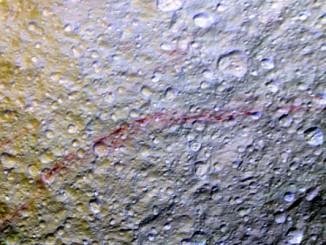
Lunar and Planetary Institute



Saturn’s clouds run deep, rings may rain organics
Saturn’s clouds have roots deeper inside the planet’s atmosphere than scientists previously thought, and Saturn’s rings — now believed to have formed in the last 200 million years — appear to be raining organic molecules down on the planet, according to observations made by NASA’s Cassini spacecraft last year in the final weeks of its mission.

Asteroids identified as source of Moon’s water
According to a new international study, most (>80 percent) of the water inside the Moon was delivered by asteroids similar to carbonaceous chondritic meteorites during the early lunar evolution, approximately 4.5—4.3 billion years ago. A similar delivery of water to the Earth would have been occurring within this same interval of time.

New details on Ceres seen in Dawn images
Features on dwarf planet Ceres that piqued the interest of scientists throughout 2015 stand out in exquisite detail in the latest images from NASA’s Dawn spacecraft, which recently reached its lowest-ever altitude at Ceres. Dawn took these images near its current altitude of 240 miles (385 kilometers) between 19 and 23 December 2015.

Dawn gets the lowdown on dwarf planet Ceres
NASA’s Dawn spacecraft, cruising in its lowest and final orbit at dwarf planet Ceres, has delivered the first images from its best-ever viewpoint. The new images showcase details of the cratered and fractured surface. Dawn is now approximately 240 miles (385 kilometres) above Ceres, which is where it will remain for the rest of its mission.

Ceres’ mysterious bright spots and 4-mile-tall pyramidal mountain in 3-D
Since its arrival at dwarf planet Ceres on 6 March this year, NASA’s Dawn spacecraft has been slowly spiralling closer to this enigmatic little world. Mission scientist are nearer finding explanations for the intriguing bright spots in a crater named Occator and why an isolated mountain — as high as any in North America — is sitting in the middle of nowhere.

Unusual red arcs discovered on icy Saturnian moon
Like graffiti sprayed by an unknown artist, unexplained narrow, arc-shaped, reddish streaks are visible on the surface of Saturn’s icy moon Tethys in new, enhanced-colour images from NASA’s Cassini spacecraft. The red arcs are among the most unusual colour features on Saturn’s moons to be revealed by Cassini’s cameras.

New names and insights at dwarf planet Ceres
Colourful new maps of Ceres, based on data from NASA’s Dawn spacecraft, showcase a diverse topography, with height differences between crater bottoms and mountain peaks as great as 9 miles (15 kilometres). Some of these craters and other features now have official names, inspired by spirits and deities relating to agriculture from a variety of cultures.
